It looks like you're using an Ad Blocker.
Please white-list or disable AboveTopSecret.com in your ad-blocking tool.
Thank you.
Some features of ATS will be disabled while you continue to use an ad-blocker.
share:
englishrussia.com...
these planes are crazy,,,,, i never knew they even existed,, til now.
So, it's a huge plane that basically never gets over 10 feet of the ground.
i know ats has some great aircraft afficionados,,,,, any opinions,, stories etc to go along with these mamoth planes that never really get off the ground,,or water
An “ekranoplan” literally “screen plane” is a vehicle resembling an aircraft, but operating solely on the principle of ground effect. Ground effect vehicles (GEV) fly above any flat surface, with the height above ground dependent upon the size of the vehicle.
The KM, as the Caspian Sea Monster was known in the top secret Soviet military development program, was over 100 m long (330 ft), weighed 540 tonnes fully loaded, and could travel over 400 km/h (250 mi/h), mere meters above the surface of the water.
The important design principle is that wing lift is reduced as operating altitude of the ekranoplan is increased (see ground effect). Thus it is dynamically stable in the vertical dimension. Once moving at speed, the ekranoplan was no longer in contact with the water, and could move over ice, snow, or level land with equal ease.
these planes are crazy,,,,, i never knew they even existed,, til now.
So, it's a huge plane that basically never gets over 10 feet of the ground.
i know ats has some great aircraft afficionados,,,,, any opinions,, stories etc to go along with these mamoth planes that never really get off the ground,,or water
reply to post by shortywarn
These are very interesting. I am curious as to what advantages they have over conventional aircraft. I guess one is less distance to fall in event of a crash. I wonder if they are more fuel efficient? I cant imagine that they turn very sharp or are faster than a conventional plane. I would also love to hear from any aviation experts.
Good find
***Guess I should have read more carefully: "one of several Russian military designs meant to fly only a few meters above water, saving energy and staying below enemy radar."
[edit on 5-6-2009 by iamcamouflage]
These are very interesting. I am curious as to what advantages they have over conventional aircraft. I guess one is less distance to fall in event of a crash. I wonder if they are more fuel efficient? I cant imagine that they turn very sharp or are faster than a conventional plane. I would also love to hear from any aviation experts.
Good find
***Guess I should have read more carefully: "one of several Russian military designs meant to fly only a few meters above water, saving energy and staying below enemy radar."
[edit on 5-6-2009 by iamcamouflage]
Hm, that's weird.
I don't understand why they can't go higher!!
Aren't they generating lift due to the air over the wings?
I don't understand why they can't go higher!!
Aren't they generating lift due to the air over the wings?
It seems like an idea a giant bureaucracy would pursue. Someone up high says that they want this and anyone who complains gets axed so they make the
darn thing. Great, a plane that you don't need a parachute to jump from.
There would also be the advantage of not showing up on radar or sonar in certain situations
Think about it. The Ekranoplanes fly in ground effect over the ocean. Flying in ground effect is how such a large plane can fly so efficiently.
That means they never get more than about 15 or 20 feet above the waves. Would you fly in an aircraft at 300 mph 15 ft above the ocean? Under sea
conditions that could produced storm waves of 30 or 40 feet?
Didn't think so. That's why the Ekranoplane concept never panned out. The Soviet military pursued it as a heavy military transport for use on the Black Sea, where the waves never get very big.
Otherwise, it was about as practical as the US military's Atomic Annie or Davy Crockett:
upload.wikimedia.org...
Warmest regards,
Riff-Raff
Didn't think so. That's why the Ekranoplane concept never panned out. The Soviet military pursued it as a heavy military transport for use on the Black Sea, where the waves never get very big.
Otherwise, it was about as practical as the US military's Atomic Annie or Davy Crockett:
upload.wikimedia.org...
Warmest regards,
Riff-Raff
reply to post by shortywarn
It may fly, but its use of ground effect (over water) still makes it a plane. The advantage of ground effect aircraft (a glorified boat?) is so interesting because by using an air bubble-layer you vastly reduce the biggest problem with conventional ships which is water-hull friction, it still is. Fuel economy would be fabulous. In the 1960's the Soviets put a lot of money into these technologies. From what I know about this (not a great deal but did study the technology in the late 60's/early 70's) the biggest problem was lack of computer systems that could quickly compensate for air-to-surface turbulance. The technology remains most promising, more so now given computers the Russians now have. The advantage of this technology is tremendously effective.
The closest we have designed in this area was the infamous "spruce goose" built by Mr. Hughes in the late 1940's. But it was a pain in the butt to fly, and to0 late for WW-2. The lack of hull-water/turbulance was hindered by the goose being a nightmare to fly. My guese if you ever saw a picticture of the goose, one look at the the "goose" a tremendous technical achieviement. The ability to "manage " the cockpit had among the most complexity of any plane to fly, yet with pretty basic computer control moderation, with most I am quite aware of of which I can no doubt, we can overcome this. To suggest this tecnology has no purpose is like saying hellicopters have no use to advance the technical systems,not to employ most in in systems and cockpit and computer control, is nonsense
A great approach is to work with the Russians as a show of trust and commen sense. And no, we are not talking giving them truly secret technology such as in our F-22'or Lighting Two. Aside from a gesture of peace (by showing trust). This type of aircraft-flying boat would in theory be an economic bonanze for both nations. This concept is a great idea, for nothing else priority that can fly safely at over 300mps plus. For troop deployment, fed ex, you name it with current technology, our options are wide open. You could use less technology then the Boing 777, or an Airbus. Time to get to work gang. Lets not take to much time because someone will build a craft with this capacity. It's use with search and rescue would be priceless. Let's get off our butt on this one gang.
It may fly, but its use of ground effect (over water) still makes it a plane. The advantage of ground effect aircraft (a glorified boat?) is so interesting because by using an air bubble-layer you vastly reduce the biggest problem with conventional ships which is water-hull friction, it still is. Fuel economy would be fabulous. In the 1960's the Soviets put a lot of money into these technologies. From what I know about this (not a great deal but did study the technology in the late 60's/early 70's) the biggest problem was lack of computer systems that could quickly compensate for air-to-surface turbulance. The technology remains most promising, more so now given computers the Russians now have. The advantage of this technology is tremendously effective.
The closest we have designed in this area was the infamous "spruce goose" built by Mr. Hughes in the late 1940's. But it was a pain in the butt to fly, and to0 late for WW-2. The lack of hull-water/turbulance was hindered by the goose being a nightmare to fly. My guese if you ever saw a picticture of the goose, one look at the the "goose" a tremendous technical achieviement. The ability to "manage " the cockpit had among the most complexity of any plane to fly, yet with pretty basic computer control moderation, with most I am quite aware of of which I can no doubt, we can overcome this. To suggest this tecnology has no purpose is like saying hellicopters have no use to advance the technical systems,not to employ most in in systems and cockpit and computer control, is nonsense
A great approach is to work with the Russians as a show of trust and commen sense. And no, we are not talking giving them truly secret technology such as in our F-22'or Lighting Two. Aside from a gesture of peace (by showing trust). This type of aircraft-flying boat would in theory be an economic bonanze for both nations. This concept is a great idea, for nothing else priority that can fly safely at over 300mps plus. For troop deployment, fed ex, you name it with current technology, our options are wide open. You could use less technology then the Boing 777, or an Airbus. Time to get to work gang. Lets not take to much time because someone will build a craft with this capacity. It's use with search and rescue would be priceless. Let's get off our butt on this one gang.
reply to post by shortywarn
It's really late and I'm about to drop. But the basics; the Russians designed this plane in the late 1960's. The greatest problem with any "ship in the water" is hull/water friction which greatly reduces the speed of any ship. Flying on an air bubble is far more economical; other ships certain classified hulls are quite effective for greatly reducing hull/water friction. You have coatings that we use for some subs that change the coefficiant of friction between hull and water. Also helps with stealth, though I can't go into details on the chemistry of same (I was involved in the design of some of these materials). Second options is to create nose cavitation that creates an air layer between water and hull. Far as I know this is used for sub-flank-speed, and some Russian torpedos.The speed is highly classified but you can get idea of the basics by googling skua or squawl/or Russian torpedo technology. It is stated in the open press the MINIMUM speed of these torps is about 500 plus miles per hour. The Russians a number of years ago had a torpedo that because it had a probe that created a noisy then hull creating a cavitation based air bubble around the torpedo, so in fact it changed the whole strategic situation, for a while. This torpedo was moving threw the "air and not water" in a bubble of air, not water. Speed was fantastic. Loud, but open source media has claimed with the minimum speed, you could hear the dam thing accross the hundreds of miles, but moving at 500-600 mph, some say they can go supersonic the bloody thing could be a brass band, would it make a difference? I don't think so. Don't believe me? Google it, look it up, whatever. By the way the skua is rocket propelled, with a extended nose probe that creates a nose based cavitation that surronds the torp.
The anti-detection methods for our subs/ships remain highly classified. The technology, for the most part computers were very primitive in the 6'0/70/and even 1980's was not up to the task of controling turbulance and other when the Russians were working on the technology, concerning computers were just not good enough. The closest we came to build a trully big flying boat was the "slow,big,and a nightmare to fly" Hughs "spruce goose". Three things killed it. It's slow speed was considered a sitting, and a very fat duck at that. Also it's lifting capacity was made redundent regarding sea power so late in WW-2 we had established good island based air fields with planes that were faster, also our sea lift capacity had limited the U-Boat problem.
But the biggest problem with the plane getting "goosed" was the flight technology was just to primitive, and hard to fly. We think the Russians had the same problem with the name I know it as; the econoplane, which had the same problem (Russians). With all cable to control surfaces and a gazillion dials to keep track of and was quite lethal to fly, a real nightmare. Everyhing I have heard about the "flying boat" was it was like the spruce goose a real bear, no pun intended to fly. The advantage of a flying, even a real big one, was no direct contact with water on the hull. This created what could have been a very efficiant sea based air plane. boat, whatever you want to call it. The friction of a hull not in the water far surpassed any ship/sub or conventional torpedo of the time. Speed of the skua far exceeded or main torpedo, though upgraded over many years, the ADCAP that years, that so many years later we still employ even after decades. It's one mean dude of a torpedo.
We have numerous ways of of reducing "hull in water friction". The ones are available in the ocean are for the most three; friction reducing coatings, of which I worked on. The use of accoustic resonance that would create a "hull-to-water harmonic", cavitation (using this you will soud like a brass band accross the ocean, but its for :we need to get the hell out of here)
I would siggest we use modern tecnology to augment controls on a new version of the econoplane. The technology would be no more advanced then a Boing 777. Trus me, the Russians have all our commercial airliners. Were not talking about giving them F-22/F-35 technology.Our aviation production is if not superior, but is more efficient then what they have. But they have excellent engineers. It would be a great gesture of co-operation. I would never consider giving any one classified technology, and we just don't need to to make this work.
The use of a plane like this would be every thing from search and rescue, heavy transports (since they are seaplanes we don't need huge air fields. In fact few airfields would accomadate such a massive aircraft). This sense of aircraft/boat, whatever by creating a bubble of air under it. It's fuel economy could be really fantastic, not to mention the ability of landing on 70% plus of the Earths surface.I could think of dozens of applications for something like this. One or two good ones, it becomes economical. More later as I can get further details. Pax Humana Pax gang, and good night...
It's really late and I'm about to drop. But the basics; the Russians designed this plane in the late 1960's. The greatest problem with any "ship in the water" is hull/water friction which greatly reduces the speed of any ship. Flying on an air bubble is far more economical; other ships certain classified hulls are quite effective for greatly reducing hull/water friction. You have coatings that we use for some subs that change the coefficiant of friction between hull and water. Also helps with stealth, though I can't go into details on the chemistry of same (I was involved in the design of some of these materials). Second options is to create nose cavitation that creates an air layer between water and hull. Far as I know this is used for sub-flank-speed, and some Russian torpedos.The speed is highly classified but you can get idea of the basics by googling skua or squawl/or Russian torpedo technology. It is stated in the open press the MINIMUM speed of these torps is about 500 plus miles per hour. The Russians a number of years ago had a torpedo that because it had a probe that created a noisy then hull creating a cavitation based air bubble around the torpedo, so in fact it changed the whole strategic situation, for a while. This torpedo was moving threw the "air and not water" in a bubble of air, not water. Speed was fantastic. Loud, but open source media has claimed with the minimum speed, you could hear the dam thing accross the hundreds of miles, but moving at 500-600 mph, some say they can go supersonic the bloody thing could be a brass band, would it make a difference? I don't think so. Don't believe me? Google it, look it up, whatever. By the way the skua is rocket propelled, with a extended nose probe that creates a nose based cavitation that surronds the torp.
The anti-detection methods for our subs/ships remain highly classified. The technology, for the most part computers were very primitive in the 6'0/70/and even 1980's was not up to the task of controling turbulance and other when the Russians were working on the technology, concerning computers were just not good enough. The closest we came to build a trully big flying boat was the "slow,big,and a nightmare to fly" Hughs "spruce goose". Three things killed it. It's slow speed was considered a sitting, and a very fat duck at that. Also it's lifting capacity was made redundent regarding sea power so late in WW-2 we had established good island based air fields with planes that were faster, also our sea lift capacity had limited the U-Boat problem.
But the biggest problem with the plane getting "goosed" was the flight technology was just to primitive, and hard to fly. We think the Russians had the same problem with the name I know it as; the econoplane, which had the same problem (Russians). With all cable to control surfaces and a gazillion dials to keep track of and was quite lethal to fly, a real nightmare. Everyhing I have heard about the "flying boat" was it was like the spruce goose a real bear, no pun intended to fly. The advantage of a flying, even a real big one, was no direct contact with water on the hull. This created what could have been a very efficiant sea based air plane. boat, whatever you want to call it. The friction of a hull not in the water far surpassed any ship/sub or conventional torpedo of the time. Speed of the skua far exceeded or main torpedo, though upgraded over many years, the ADCAP that years, that so many years later we still employ even after decades. It's one mean dude of a torpedo.
We have numerous ways of of reducing "hull in water friction". The ones are available in the ocean are for the most three; friction reducing coatings, of which I worked on. The use of accoustic resonance that would create a "hull-to-water harmonic", cavitation (using this you will soud like a brass band accross the ocean, but its for :we need to get the hell out of here)
I would siggest we use modern tecnology to augment controls on a new version of the econoplane. The technology would be no more advanced then a Boing 777. Trus me, the Russians have all our commercial airliners. Were not talking about giving them F-22/F-35 technology.Our aviation production is if not superior, but is more efficient then what they have. But they have excellent engineers. It would be a great gesture of co-operation. I would never consider giving any one classified technology, and we just don't need to to make this work.
The use of a plane like this would be every thing from search and rescue, heavy transports (since they are seaplanes we don't need huge air fields. In fact few airfields would accomadate such a massive aircraft). This sense of aircraft/boat, whatever by creating a bubble of air under it. It's fuel economy could be really fantastic, not to mention the ability of landing on 70% plus of the Earths surface.I could think of dozens of applications for something like this. One or two good ones, it becomes economical. More later as I can get further details. Pax Humana Pax gang, and good night...
reply to post by shortywarn
Heres a pretty good video I hope it hasn't been posted yet.
I checked but didn't see anything
Heres a pretty good video I hope it hasn't been posted yet.
I checked but didn't see anything
Hi,
Fascinating planes indeed and if the following projects gain sufficient funding it will become even more so. At these sizes i think they might very well become competitive with shipping in terms of speed freight delivery...
en.wikipedia.org...
en.wikipedia.org...
Stellar
Fascinating planes indeed and if the following projects gain sufficient funding it will become even more so. At these sizes i think they might very well become competitive with shipping in terms of speed freight delivery...
en.wikipedia.org...
en.wikipedia.org...
Stellar
Thats wierd I was just going to put a therad together about
the Ekranoplanes and other GEV's.
I ran across some photos of one rusting away at a dock in russia.
they were a fascinating idea that would compliment aircraft, rail and trucks in supply logistics.
the Ekranoplanes and other GEV's.
I ran across some photos of one rusting away at a dock in russia.
they were a fascinating idea that would compliment aircraft, rail and trucks in supply logistics.
The ekranoplanes are certainly fascinating from the technological standpoint, and these Russian projects helped gather a lot of data and information
on how to improve the technology and viability - even though the military ekranoplanes never materialized.
While you could definitely see them make a comeback (as freight carriers) in a decade or two, it won't be soon. Due to the economic crisis the international shipping industry suffered substantially and saw a major decrease in business and an increase in spare capacity. As long as this spare capacity remains, new costly projects like ekranoplanes will be held off.
From what I understand Russia still has a number of smaller ekranoplanes that can still be retured to operational condition. Data and blueprints from the largers planes also still exists. If somebody shows commercial interest, Russia could get production set up fairly rapidly. The Beriev aircraft company has a fairly good number of projects and sales right now to be able to fund research in this field.
While you could definitely see them make a comeback (as freight carriers) in a decade or two, it won't be soon. Due to the economic crisis the international shipping industry suffered substantially and saw a major decrease in business and an increase in spare capacity. As long as this spare capacity remains, new costly projects like ekranoplanes will be held off.
From what I understand Russia still has a number of smaller ekranoplanes that can still be retured to operational condition. Data and blueprints from the largers planes also still exists. If somebody shows commercial interest, Russia could get production set up fairly rapidly. The Beriev aircraft company has a fairly good number of projects and sales right now to be able to fund research in this field.
reply to post by maloy
They did build miltary versions they were all military versions.
The last big one the MD160"Lun"
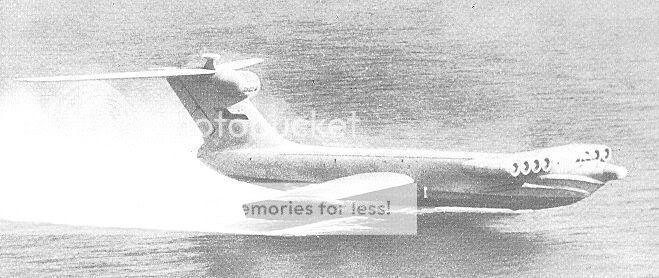
This model could also fly up to 23k feet.
And they gave it some teeth
6 sunburn missles

A fleet of these would have been a formidable foe , firing off a salvo of sunburns.
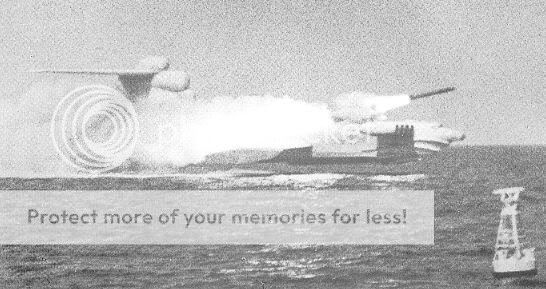
The Lun
The Monster of the Caspian Sea
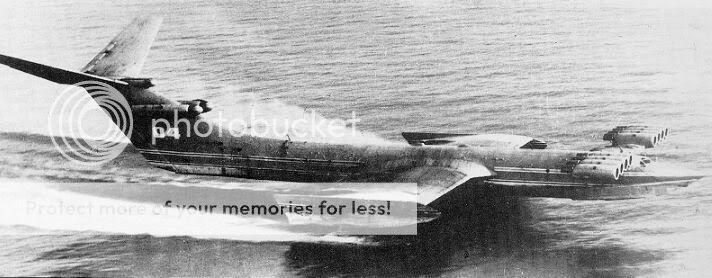
Various other shots of ekranoplanes
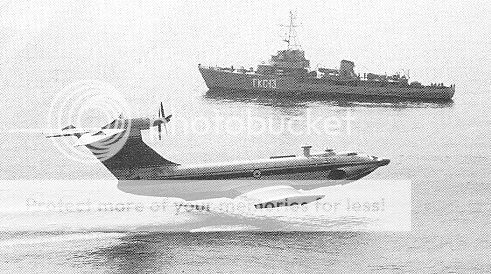
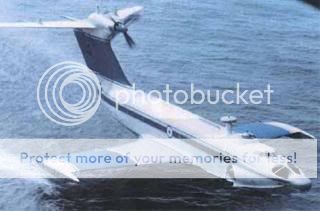


The journey to its final resting place for an ekranoplane
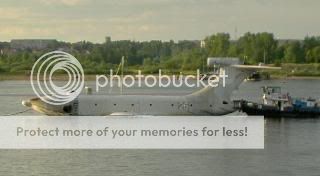
Its resting place, a Soviet themed theme park
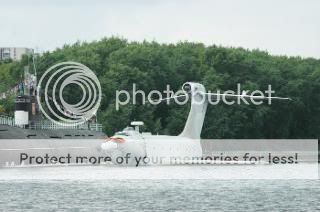
More about ekranoplanes and WIGs in general
Wigs
[edit on 7-6-2009 by punkinworks09]
[edit on 7-6-2009 by punkinworks09]
[edit on 7-6-2009 by punkinworks09]
They did build miltary versions they were all military versions.
The last big one the MD160"Lun"

This model could also fly up to 23k feet.
And they gave it some teeth
6 sunburn missles

A fleet of these would have been a formidable foe , firing off a salvo of sunburns.

The Lun
The Monster of the Caspian Sea

Various other shots of ekranoplanes




The journey to its final resting place for an ekranoplane

Its resting place, a Soviet themed theme park

More about ekranoplanes and WIGs in general
Wigs
[edit on 7-6-2009 by punkinworks09]
[edit on 7-6-2009 by punkinworks09]
[edit on 7-6-2009 by punkinworks09]
reply to post by punkinworks09
Yes they were all military models, but all of them were test and experimental versions and none had entered actual service in sufficient numbers. That is what I meant.
Yes they were all military models, but all of them were test and experimental versions and none had entered actual service in sufficient numbers. That is what I meant.
Originally posted by SLAYER69
reply to post by shortywarn
Heres a pretty good video I hope it hasn't been posted yet.
I checked but didn't see anything
Best picture I ever saw.
A company was set up here in the 90s to commercially produce these 'ekranoplans' for domestic and cargo purposes (Sea Wing International) but it
folded without ever producing one despite the great hopes from all the way up to the then PM.
I've seen small 1 or 2 seater versions produced in the USA also - toys for the filthy rich.
[edit on 9/6/2009 by Pilgrum]
I've seen small 1 or 2 seater versions produced in the USA also - toys for the filthy rich.
[edit on 9/6/2009 by Pilgrum]
There are lots of practical issues with these Ekranoplanes. They are safe to fly over calm waters like the Black Sea, but would be too dangerous over
open oceans.
There is also the issue of corrosion. An aluminum airframe in salt water would not last long. And the turbine engines would have corrosion problems without air filters.
Finally, a seaplane that cannot fly over land is not really all that practical.
Here's Boeing's take on the concept: www.aviationexplorer.com...
As for International relations, Boeing is a partner in the Russian Superjet program. And NASA has a long working relationship with Russian space effort.
There is also the issue of corrosion. An aluminum airframe in salt water would not last long. And the turbine engines would have corrosion problems without air filters.
Finally, a seaplane that cannot fly over land is not really all that practical.
Here's Boeing's take on the concept: www.aviationexplorer.com...
As for International relations, Boeing is a partner in the Russian Superjet program. And NASA has a long working relationship with Russian space effort.
new topics
-
Maestro Benedetto
Literature: 6 minutes ago -
Is AI Better Than the Hollywood Elite?
Movies: 15 minutes ago -
Las Vegas UFO Spotting Teen Traumatized by Demon Creature in Backyard
Aliens and UFOs: 3 hours ago -
2024 Pigeon Forge Rod Run - On the Strip (Video made for you)
Automotive Discussion: 4 hours ago -
Gaza Terrorists Attack US Humanitarian Pier During Construction
Middle East Issues: 4 hours ago -
The functionality of boldening and italics is clunky and no post char limit warning?
ATS Freshman's Forum: 6 hours ago -
Meadows, Giuliani Among 11 Indicted in Arizona in Latest 2020 Election Subversion Case
Mainstream News: 6 hours ago -
Massachusetts Drag Queen Leads Young Kids in Free Palestine Chant
Social Issues and Civil Unrest: 6 hours ago -
Weinstein's conviction overturned
Mainstream News: 8 hours ago -
Supreme Court Oral Arguments 4.25.2024 - Are PRESIDENTS IMMUNE From Later Being Prosecuted.
Above Politics: 9 hours ago
top topics
-
Krystalnacht on today's most elite Universities?
Social Issues and Civil Unrest: 9 hours ago, 9 flags -
Supreme Court Oral Arguments 4.25.2024 - Are PRESIDENTS IMMUNE From Later Being Prosecuted.
Above Politics: 9 hours ago, 8 flags -
Weinstein's conviction overturned
Mainstream News: 8 hours ago, 7 flags -
University of Texas Instantly Shuts Down Anti Israel Protests
Education and Media: 12 hours ago, 6 flags -
Massachusetts Drag Queen Leads Young Kids in Free Palestine Chant
Social Issues and Civil Unrest: 6 hours ago, 6 flags -
Gaza Terrorists Attack US Humanitarian Pier During Construction
Middle East Issues: 4 hours ago, 6 flags -
Meadows, Giuliani Among 11 Indicted in Arizona in Latest 2020 Election Subversion Case
Mainstream News: 6 hours ago, 5 flags -
Las Vegas UFO Spotting Teen Traumatized by Demon Creature in Backyard
Aliens and UFOs: 3 hours ago, 3 flags -
2024 Pigeon Forge Rod Run - On the Strip (Video made for you)
Automotive Discussion: 4 hours ago, 2 flags -
Any one suspicious of fever promotions events, major investor Goldman Sachs card only.
The Gray Area: 14 hours ago, 2 flags
active topics
-
University of Texas Instantly Shuts Down Anti Israel Protests
Education and Media • 210 • : DBCowboy -
Is AI Better Than the Hollywood Elite?
Movies • 1 • : 5thHead -
British TV Presenter Refuses To Use Guest's Preferred Pronouns
Education and Media • 164 • : Annee -
VP's Secret Service agent brawls with other agents at Andrews
Mainstream News • 56 • : CarlLaFong -
Maestro Benedetto
Literature • 0 • : BrotherKinsMan -
Massachusetts Drag Queen Leads Young Kids in Free Palestine Chant
Social Issues and Civil Unrest • 11 • : marg6043 -
Electrical tricks for saving money
Education and Media • 7 • : chr0naut -
Definitive 9.11 Pentagon EVIDENCE.
9/11 Conspiracies • 424 • : Zanti Misfit -
Las Vegas UFO Spotting Teen Traumatized by Demon Creature in Backyard
Aliens and UFOs • 8 • : Macenroe82 -
SHORT STORY WRITERS CONTEST -- April 2024 -- TIME -- TIME2024
Short Stories • 23 • : DontTreadOnMe

